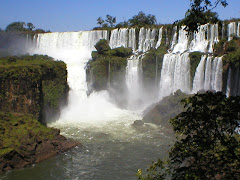The fun part of being a non-literalistic fan of the bible is that one can tolerate the many discrepancies held within these "sacred" texts. And among the best of the best in confusing events (with second place going to the feeding of a large number of people) is the Easter story. Here are but a few of the wonderful parts of this story in the form of a little quiz (answers included):
1. How many women went to the tomb early that morning (before sunrise as in John, after sunrise as in Matt and Mark)? Was it just Mary Magdalene by herself (John)? A whole bunch (Mary M, Mary Mom, Joanna, and their friends in Luke)? Or was it three (Mary M, Mary mom, and Salome in Mark)?
2. Then there was that confounded stone - was it rolled away (as in Mark, Luke and John's account) or by the angel after they/she arrived (Matt's version)? And while we are at it, how many angels or young men were there: two (John and Luke) or one (Matt and Mark)? And where were they? Inside the tomb (Mark and John) sitting on the stone after rolling it away (Matt) or suddenly appearing standing beside them (Luke)?
3. Ah, but what did the one or two angels or men say? "Woman (to Mary M) why are you crying (John)?" "Don't be afraid - you are looking for Jesus (Matt and Mark)" "Why do you look for the living among the dead? He is not here (Luke)"
4. Now here is the stumper: What did the women do or say? Did they flee from the tomb saying nothing to anyone, despite being instructed to tell Peter and the Disciples (Mark); hurry away to tell the Disciples (Matt); bow in reverence, remembering what Jesus had told them, whereupon they "returned" to tell the Disciples (Luke); or stand there crying and say, "They have taken my Lord away." (John)?
5. And then, we have to deal with the guys themselves. What was the reaction of the 12? Mark doesn't mention any, Matt says they went to Galilee as instructed, Luke says they did not believe the women, but Peter ran to the tomb to see for himself, and John says that both Peter and the beloved disciple (presumably John) both ran to the tomb.
Bonus Question: When and where did Jesus appear and to whom? If you side with John, he appeared to Mary Magdalene right then and there at the tomb, engaged in conversation with her but warned her not to touch the merchandise as he had not yet returned to his father. Matt says he appeared to the women on the way back shortly after they left. Then Luke says that the first appearance wasn't till later that day as two of the disciples were walking to Emmaus. Poor Mark missed class the day they discussed the appearance and doesn't mention it at all! And least we forget, in 1 Corinthians, Peter claims to have seen him first, but that wasn't part of the contest.
So what do we make of this remarkable comedy of errors? Well if any of you had ever been at an astounding event, or traumatic event, you quickly know what happened here. Recall for example what you and your friends and colleagues did and said on 9/11. Then compare stories with them and you will find that no one tells the same story. Oh yea the towers fell, and some planes hit them, but the story of what you and they discussed will vary quite a bit, and that is what happened here. So overwhelming was the execution and days following that event that the telling and retelling of those accounts many times before writing them down, resulted in these wildly varying accounts, no one of which can be trusted literally as the god's honest truth.
What is true is that something happened and and it was pretty shaking. What is true is that we are still astounded by that event. And what is true is how that event lands on you. What you choose to believe is your Easter experience and that is all that matters.
Sunday, April 8, 2012
Thursday, April 5, 2012
The Gospel According to...
I had the opportunity of talking to my son's midrasha class on the occasion of the coincidence of Maundy Thursday and erev Pesach. It was only the remnants of his class as a town dance thinned the numbers quite a bit but it was interesting to hear what might have been taught as Christianity by their teacher and to be able to contrast that with some thoughts from a modern day theology student.
I started off by separating the stories of Jesus from the history of Christianity (ugh!). I spoke of Jeshua the Rabbi and his message from the Torah - his message straight out of Deuteronomy and Leviticus. Love your enemies, free the slaves, care for the sick, feed and clothe the poor and lift up the widowed, and orphaned and children. All these things the the kids had learned as mitzvoth - and they were this Rabbi's messages. But what happened in chronicling and documenting that message was completely another story. They had no idea that at one point there were perhaps hundreds of "gospel" stories (Read Luke 1:1) but that only these four accounts were selected because they best represented what the prevailing theology of the time (ca. 100-300 CE) believed and wished to portray. They saw Christians (with plenty of good reason) as literalists but did not realize that our biblical stories, like theirs, were subject to revision and adaptation.
For example, I asked them what the Romans were like. Few really knew the unabridged version of Roman culture, of their lust for blood and sport of killing. Why then, I asked would there be little of no reference to the Roman tyranny in the books of the Christian bible? Because would you risk writing anything negative about a people who would think nothing of finding a reason to kill you? So perhaps as Rabbi Shmuel Boteach writes (Kosher Jesus), they might be inclined to whitewash the text and finger the Jews or the ruling class of the priesthood as the bad guys. After a few centuries of telling the story the the bad guys became the killers, and in the name of telling a story of crucifixion and resurrection, antisemitism became institutionalized in the catholic church.
But that was not the message of this man (who never once referred to himself as the Messiah or meshiach). I also pointed out the many similarities between a Christian service, our ritual prayers and sacraments as rooted in or directly lifted from the Shabbat service. And that today we (mostly) believe that the day before his trial and execution at the hands of the Romans, these followers and their rabbi gathered to remember the Passover, to share unleavened bread and drink wine in whatever the seder rituals of the day prescribed.
I only had a half hour to get this out and there are so many things that need to be untangled - what's this trinity thing and how can you explain the crusades. We just did not get there. But perhaps for three kids and my son, today a few of us bridged a little bit of the gap. And I would like to think that I might be invited back to talk again for a little bit more time in an open forum with the Rabbi and the whole class. That would be nice.
I started off by separating the stories of Jesus from the history of Christianity (ugh!). I spoke of Jeshua the Rabbi and his message from the Torah - his message straight out of Deuteronomy and Leviticus. Love your enemies, free the slaves, care for the sick, feed and clothe the poor and lift up the widowed, and orphaned and children. All these things the the kids had learned as mitzvoth - and they were this Rabbi's messages. But what happened in chronicling and documenting that message was completely another story. They had no idea that at one point there were perhaps hundreds of "gospel" stories (Read Luke 1:1) but that only these four accounts were selected because they best represented what the prevailing theology of the time (ca. 100-300 CE) believed and wished to portray. They saw Christians (with plenty of good reason) as literalists but did not realize that our biblical stories, like theirs, were subject to revision and adaptation.
For example, I asked them what the Romans were like. Few really knew the unabridged version of Roman culture, of their lust for blood and sport of killing. Why then, I asked would there be little of no reference to the Roman tyranny in the books of the Christian bible? Because would you risk writing anything negative about a people who would think nothing of finding a reason to kill you? So perhaps as Rabbi Shmuel Boteach writes (Kosher Jesus), they might be inclined to whitewash the text and finger the Jews or the ruling class of the priesthood as the bad guys. After a few centuries of telling the story the the bad guys became the killers, and in the name of telling a story of crucifixion and resurrection, antisemitism became institutionalized in the catholic church.
But that was not the message of this man (who never once referred to himself as the Messiah or meshiach). I also pointed out the many similarities between a Christian service, our ritual prayers and sacraments as rooted in or directly lifted from the Shabbat service. And that today we (mostly) believe that the day before his trial and execution at the hands of the Romans, these followers and their rabbi gathered to remember the Passover, to share unleavened bread and drink wine in whatever the seder rituals of the day prescribed.
I only had a half hour to get this out and there are so many things that need to be untangled - what's this trinity thing and how can you explain the crusades. We just did not get there. But perhaps for three kids and my son, today a few of us bridged a little bit of the gap. And I would like to think that I might be invited back to talk again for a little bit more time in an open forum with the Rabbi and the whole class. That would be nice.
Labels:
ecumenism,
education,
Jesus teaching,
ritual,
sabbath
Subscribe to:
Comments (Atom)
.jpg)


